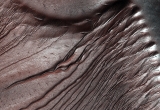Dry ice sublimation process behind the formation of Martian gullies
Gullies observed on Mars would be produced by the action of dry ice in winter and spring, not by liquid water flows as thought before. Indeed, recent numerical simulations show that under dry ice heated by the Sun, intense gas motions can destabilize and fluidize the soil, until they create flows similar to those created by a liquid.
Since 2000, the cameras in orbit around Mars have transmitted numerous images of small valleys cut into slopes, similar in shape to gullies formed by flowing water on Earth. The gullies seem less than a few million years old—and sometimes less than a few years old. This suggested that significant volumes of liquid water may form on Mars today.
This scenario has recently been questioned by frequent monitoring of the Martian surface by the HiRISE camera aboard NASA Mars Reconnaissance Orbiter (MRO). This revealed that gully formation is ongoing on present-day Mars, at seasons when the surface environment of Mars is much too cold for liquid water to flow. However, observations by HiRISE on MRO and a recent study lead by M. Vincendon from IAS (with infrared spectroscopy data from OMEGA on Mars Express and CRISM on MRO) have shown that the observed gully activity seems to occur when CO2 ice (condensed from the atmosphere during winter) is defrosting on the Martian surface. How can we explain that a thin seasonal layer of CO2 frost (a few tens of cm thick) can lead to the formation of fluidized flows involving tens, or even hundreds of m3 of material?
Numerical models by C. Pilorget (IAS) and F. Forget (LMD), simulating the CO2 seasonal cycle on Mars, have brought new answers on the mechanisms that could be involved. In particular, these models have revealed that there were intense gas movements below the seasonal CO2 ice layer illuminated by the Sun, that could potentially destabilize and fluidize the soil to sometimes create flows similar to those generated by a liquid. Such process could explain the spatial distribution and the orientation of the slopes where the formation of channels has been observed over the last few years. Exploring the impact of obliquity, which has varied between 25 and 35° in the last million years of Mars history, has also shown a good correlation between model predictions and the general distribution of gullies on Mars. The identified mechanism, which does not require any liquid water, may thus constitute a major process in the formation of martian gullies, although the role of complementary processes is also possible.
References
Scientific paper: Pilorget C. and F. Forget. "Formation of gullies on Mars by debris flows triggered by CO2 sublimation". Nature Geoscience (2016). DOI 10.1038/ngeo2619
CNRS/INSU press release: http://www.insu.cnrs.fr/node/5591
Figure 1: Examples of Martian Gullies. Until recently they were thought to have been sculpted by flowing liquid water, but they may result from defrosting dry ice processes at the end of winter. On the right, gullies on dunes in Russel Crater (54.3°S-12.9°E) are partially covered by CO2 ice. On the left, sinuous gullies in a crater in Newton Basin (41°S-202°E). High resolution images: https://static.uahirise.org/images/wallpaper/2880/ESP_034234_1255.jpg, https://hirise.lpl.arizona.edu/PSP_003464_1380
[[{"type":"media","view_mode":"media_responsive","fid":"475","attributes":{"alt":"","class":"media-image","height":"600","typeof":"foaf:Image","width":"800"}}]]
[[{"type":"media","view_mode":"media_responsive","fid":"476","attributes":{"alt":"","class":"media-image","height":"844","typeof":"foaf:Image","width":"492"}}]]
Crédit: NASA/JPL/University of Arizona
Figure 2: The evolution of the Russel crater dune gullies over a year. Left: unfrosted gullies during spring in Martian year 28 ("MY28"). Middle: at the end of the following winter ("MY29") dunes are covered by CO2 ice. CO2 jets formed by sublimation beneath translucent CO2 ice have deposited sand grains on the ice where they form dark spots, confirming the intense subsurface activity predicted by the model. Right: In the spring of the following year, a new channel has formed.
[[{"type":"media","view_mode":"media_responsive","fid":"477","attributes":{"alt":"","class":"media-image","height":"489","typeof":"foaf:Image","width":"762"}}]]
Credit: NASA/JPL/University of Arizona




